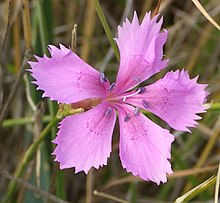|
Caryophyllales
Caryophyllales (/ˌkæri.oʊfɪˈleɪliːz/ KARR-ee-oh-fih-LAY-leez)[2] is a diverse and heterogeneous order of flowering plants that includes the cacti, carnations, amaranths, ice plants, beets, and many carnivorous plants. Many members are succulent, having fleshy stems or leaves. The betalain pigments are unique in plants of this order and occur in all its core families with the exception of Caryophyllaceae and Molluginaceae.[3] Noncore families, such as Nepenthaceae, instead produce anthocyanins.[4] In its modern definition, the order encompasses a whole new group of families (formerly included in the order Polygonales) that never synthesize betalains, among which several families are carnivorous (like Nepenthaceae and Droseraceae). According to molecular clock calculations, the lineage that led to Caryophyllales split from other plants about 111 million years ago.[5] DescriptionThe members of Caryophyllales include about 6% of eudicot species.[6] This order is part of the core eudicots.[7] Currently, the Caryophyllales contains 37 families, 749 genera, and 11,620 species[8] The monophyly of the Caryophyllales has been supported by DNA sequences, cytochrome c sequence data and heritable characters such as anther wall development and vessel-elements with simple perforations.[9] CircumscriptionAs with all taxa, the circumscription of Caryophyllales has changed within various classification systems. All systems recognize a core of families with centrospermous ovules and seeds. More recent treatments have expanded the Caryophyllales to include many carnivorous plants. Systematists were undecided on whether Caryophyllales should be placed within the rosid complex or sister to the asterid clade.[9] The possible connection between sympetalous angiosperms and Caryophyllales was presaged by Bessey, Hutchinson, and others; as Lawrence relates: "The evidence is reasonably conclusive that the Primulaceae and the Caryophyllaceae have fundamentally the same type of gynecia, and as concluded by Douglas (1936)(and essentially Dickson, 1936) '...the vascular pattern and the presence of locules at the base of the ovary point to the fact that the present much reduced flower of the Primulaceae has descended from an ancestor which was characterized by a plurilocular ovary and axial placentation. This primitive flower might well be found in centrospermal stock as Wernham, Bessy, and Hutchinson have suggested.' "[10] Caryophyllales is separated into two suborders: Caryophyllineae and Polygonineae.[9] These two suborders were formerly (and sometimes still are) recognized as two orders, Polygonales and Caryophyllales.[9]  APG IVKewaceae, Macarthuriaceae, Microteaceae, and Petiveriaceae were added in APG IV. [11] APG IIIAs circumscribed by the APG III system (2009), this order includes the same families as the APG II system (see below) plus the new families, Limeaceae, Lophiocarpaceae, Montiaceae, Talinaceae, and Anacampserotaceae.[1]
APG IIAs circumscribed by the APG II system (2003), this order includes well-known plants like cacti, carnations, spinach, beet, rhubarb, sundews, venus fly traps, and bougainvillea. Recent molecular and biochemical evidence has resolved additional well-supported clades within the Caryophyllales.
 APG   This represents a slight change from the APG system, of 1998
Cronquist The Cronquist system (1981) also recognised the order, with this circumscription:
The difference with the order as recognized by APG lies in the first place in the concept of "order". The APG favours much larger orders and families, and the order Caryophyllales sensu APG should rather be compared to subclass Caryophyllidae sensu Cronquist. A part of the difference lies with what families are recognized. The plants in the Stegnospermataceae and Barbeuiaceae were included in Cronquist's Phytolaccaceae. The Chenopodiaceae (still recognized by Cronquist) are included in Amaranthaceae by APG. New to the order (sensu APG) are the Asteropeiaceae and Physenaceae, each containing a single genus, and two genera from Cronquist's order Nepenthales. Earlier circumscriptionsEarlier systems, such as the Wettstein system, last edition in 1935, and the Engler system, updated in 1964, had a similar order under the name Centrospermae. References
External linksWikimedia Commons has media related to Caryophyllales. Wikispecies has information related to Caryophyllales.
|
||||||||||||||||||||||||||||||



